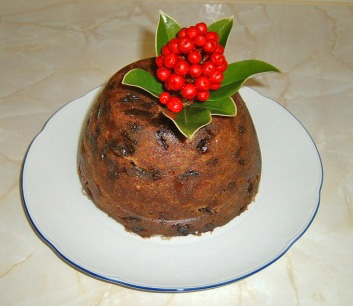Christmas pudding facts for kids

This Christmas pudding is decorated with skimmia rather than holly
|
|
| Alternative names | Plum pudding, Christmas Pudding, Pud |
|---|---|
| Type | Pudding |
| Place of origin | England, United Kingdom |
| Region or state | United Kingdom, Ireland, Australia, New Zealand, South Africa, Canada |
| Serving temperature | Warm or cold |
| Main ingredients | Sugar, treacle, suet, spices |
Christmas pudding is a special kind of pudding often eaten during Christmas dinner. It's a popular tradition in Britain, Ireland, and other countries where British people have settled. This tasty dessert started in medieval England.
Sometimes, it's called plum pudding or simply "pud." But don't let the name fool you! It doesn't actually have plums. In olden times, the word "plums" was used to mean raisins. The pudding is made with lots of dried fruits, held together with egg and suet (a type of fat). It's often made moist with treacle or molasses. It gets its yummy flavor from spices like cinnamon, nutmeg, cloves, and ginger. Christmas pudding is usually made weeks or even months before Christmas. Special ingredients help it stay fresh for a long time.
Contents
What is Christmas Pudding?
Many families have their own secret recipes for Christmas pudding. These recipes are often passed down through many generations. The pudding uses ingredients that were once very expensive. These include sweet spices that give it a rich, special smell. It is usually made with suet.
How it Looks and Tastes
Christmas pudding is very dark, almost black. This color comes from the dark sugars and black treacle used in most recipes. It also gets its dark color from being cooked for a long time. The mixture can be made moist with citrus fruit juice, brandy, or other liquids. Some recipes even use dark beers like mild, stout, or porter.
Cooking and Serving Christmas Pudding
Before the 1800s, English Christmas puddings were boiled in a special pudding cloth. This often made them round. Later, during the Victorian era, people started putting the batter into a bowl. Then they would steam it. After cooking, the pudding was unwrapped, placed on a plate, and decorated. A small sprig of holly was often placed on top.
The first cooking step usually involves steaming the pudding for many hours. To serve it, the pudding is steamed again to reheat it. Then, warm brandy is poured over it and set alight. This creates a beautiful flame! People often eat it with hard sauce, brandy butter, rum butter, cream, ice cream, or custard. Sometimes, it's sprinkled with caster sugar.
Lucky Charms in the Pudding
It was a fun tradition to hide small silver coins in the pudding mixture. If you found a coin in your serving, you got to keep it! People believed the coin would bring them wealth in the coming year. The most common coins were a silver threepence or a sixpence.
Other small tokens were also hidden in the pudding. These included a tiny wishbone for good luck. A silver thimble meant you would be thrifty (good at saving money). An anchor symbolized a safe journey or a safe home.
When the pudding is ready, it's turned out of its bowl and decorated with holly. Then, brandy (or sometimes rum) is poured over it and set on fire. The flaming pudding is traditionally brought to the table with a special ceremony. Everyone usually claps when it arrives!
After Christmas Day
Christmas puddings can last a very long time. Many families save one pudding from Christmas. They might eat it at another celebration later in the year, like Easter. Some people even make the next year's pudding during the previous Christmas!
Images for kids
See also
 In Spanish: Pudin de Navidad para niños
In Spanish: Pudin de Navidad para niños






